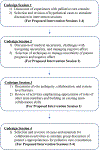The codesign of an interdisciplinary team-based intervention regarding initiating palliative care in pediatric oncology
- PMID: 29627863
- PMCID: PMC6379076
- DOI: 10.1007/s00520-018-4190-5
The codesign of an interdisciplinary team-based intervention regarding initiating palliative care in pediatric oncology
Abstract
Purpose: Children with advanced cancer are often not referred to palliative or hospice care before they die or are only referred close to the child's death. The goals of the current project were to learn about pediatric oncology team members' perspectives on palliative care, to collaborate with team members to modify and tailor three separate interdisciplinary team-based interventions regarding initiating palliative care, and to assess the feasibility of this collaborative approach.
Methods: We used a modified version of experience-based codesign (EBCD) involving members of the pediatric palliative care team and three interdisciplinary pediatric oncology teams (Bone Marrow Transplant, Neuro-Oncology, and Solid Tumor) to review and tailor materials for three team-based interventions. Eleven pediatric oncology team members participated in four codesign sessions to discuss their experiences with initiating palliative care and to review the proposed intervention including patient case studies, techniques for managing uncertainty and negative emotions, role ambiguity, system-level barriers, and team communication and collaboration.
Results: The codesign process showed that the participants were strong supporters of palliative care, members of different teams had preferences for different materials that would be appropriate for their teams, and that while participants reported frustration with timing of palliative care, they had difficulty suggesting how to change current practices.
Conclusions: The current project demonstrated the feasibility of collaborating with pediatric oncology clinicians to develop interventions about introducing palliative care. The procedures and results of this project will be posted online so that other institutions can use them as a model for developing similar interventions appropriate for their needs.
Keywords: Communication; Experience-based codesign; Interdisciplinary collaboration; Pediatric oncology; Pediatric palliative care; Role ambiguity; Team interventions; Uncertainty.
Figures
Similar articles
-
An Interprofessional Team-Based Intervention to Address Barriers to Initiating Palliative Care in Pediatric Oncology: A Multiple-Method Evaluation of Feasibility, Acceptability, and Impact.J Pain Symptom Manage. 2021 Dec;62(6):1135-1144. doi: 10.1016/j.jpainsymman.2021.06.008. Epub 2021 Jun 18. J Pain Symptom Manage. 2021. PMID: 34153461 Free PMC article.
-
The timing and circumstances of the implementation of pediatric palliative care in Hungarian pediatric oncology.Eur J Pediatr. 2018 Aug;177(8):1173-1179. doi: 10.1007/s00431-018-3170-6. Epub 2018 May 21. Eur J Pediatr. 2018. PMID: 29785662
-
Outcomes From a Patient-Centered, Interprofessional, Palliative Consult Team in Oncology.J Natl Compr Canc Netw. 2018 Jun;16(6):719-726. doi: 10.6004/jnccn.2018.7014. J Natl Compr Canc Netw. 2018. PMID: 29891523
-
Pediatric palliative oncology: the state of the science and art of caring for children with cancer.Curr Opin Pediatr. 2018 Feb;30(1):40-48. doi: 10.1097/MOP.0000000000000573. Curr Opin Pediatr. 2018. PMID: 29189353 Review.
-
Implementing Palliative Care Interdisciplinary Teams: Consultative Versus Integrative Models.Crit Care Nurs Clin North Am. 2015 Sep;27(3):297-306. doi: 10.1016/j.cnc.2015.05.006. Epub 2015 Jul 8. Crit Care Nurs Clin North Am. 2015. PMID: 26333752 Review.
Cited by
-
Barriers and facilitators influencing referral and access to palliative care for children and young people with life-limiting and life-threatening conditions: a scoping review of the evidence.Palliat Med. 2024 Oct;38(9):981-999. doi: 10.1177/02692163241271010. Epub 2024 Sep 9. Palliat Med. 2024. PMID: 39248205 Free PMC article.
-
Co-designed point-of-care ultrasound program development and implementation at a Veterans Affairs emergency department.Intern Emerg Med. 2025 Apr 25. doi: 10.1007/s11739-025-03951-1. Online ahead of print. Intern Emerg Med. 2025. PMID: 40278961
-
Experiences with a national team-based learning program for advance care planning in pediatric palliative care.BMC Palliat Care. 2024 Aug 3;23(1):196. doi: 10.1186/s12904-024-01515-2. BMC Palliat Care. 2024. PMID: 39095834 Free PMC article.
-
A conceptual model of barriers and facilitators to primary clinical teams requesting pediatric palliative care consultation based upon a narrative review.BMC Palliat Care. 2019 Dec 21;18(1):116. doi: 10.1186/s12904-019-0504-8. BMC Palliat Care. 2019. PMID: 31864331 Free PMC article. Review.
-
Palliative Care in Pediatric Oncology and Hematopoietic Stem Cell Transplantation.Curr Oncol Rep. 2022 Feb;24(2):161-174. doi: 10.1007/s11912-021-01174-z. Epub 2022 Jan 21. Curr Oncol Rep. 2022. PMID: 35061198 Review.
References
-
- Contro N, Larson J, Scofield S, Sourkes B, Cohen H (2002) Family perspectives on the quality of pediatric palliative care. Arch Pediat Adol Med 156 (1):14–19 - PubMed
-
- Davies B, Connaughty S (2002) Pediatric end of life care: Lessons learned from parents. Journal of Nursing Administration 32 (1):5–7 - PubMed
-
- Zhukovsky D, Herzog C, Kaur G, Palmer JL, Bruera E (2009) The impact of palliative care consultation on symptom assessment, communication needs, and palliative interventions in pediatric patients with cancer. Journal of Palliative Medicine 12 (4):343–349 - PubMed
MeSH terms
Grants and funding
LinkOut - more resources
Full Text Sources
Other Literature Sources
Medical


